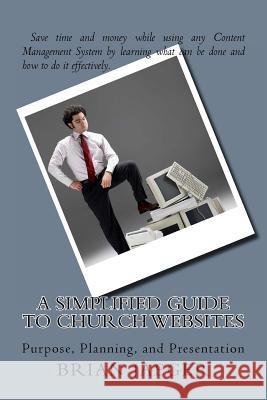A Simplified Guide to Church Websites: Purpose, Planning, and Presentation » książka
A Simplified Guide to Church Websites: Purpose, Planning, and Presentation
ISBN-13: 9781519277879 / Angielski / Miękka / 2015 / 104 str.
A Simplified Guide to Church Websites: Purpose, Planning, and Presentation
ISBN-13: 9781519277879 / Angielski / Miękka / 2015 / 104 str.
(netto: 26,64 VAT: 5%)
Najniższa cena z 30 dni: 27,97
ok. 16-18 dni roboczych
Bez gwarancji dostawy przed świętami
Darmowa dostawa!
Your church website could be better. Even if you paid a lot of money a few years ago, it's not exactly what you want. Maybe it doesn't exist at all, or maybe the volunteer who built it left for another church. While the reasons for not having a good church website are infinite, the way to create a better church website has just gotten a bit simpler with this guide designed to help anyone interested in attempting to implement a new website for a church. This is a book each minister, congregational president, and church library needs. The book starts with an argument for having a better website. If you've had trouble convincing your board or members of the need, you'll find some resources that might help. The guide then presents some suggestions about the kind of framework to use in building your new or updated site. The next part of the book takes a look at a website from top to bottom, going over most of what you'll need to create an effective design. Ratings are given for relative importance and difficulty of web page elements. The book then discusses pages of a typical church website, making some suggestions as to how to lay the pages out. You will also learn about several of the most popular and useful add-ons available for church websites. The entire book is written with budget in mind, since the author designs websites for local churches at a fraction of the cost of many custom web design businesses. The book is a pragmatic guide that covers most of what you'll need without trying to give step-by-step details, especially since it's meant to be applicable to many available systems. While the book can function as a basic guide to building your own sites, it's as much a list of suggestions that can help you navigate what you already have and what you will be shopping for when you get a website. It will help you understand what your web developer will be doing for you, whether it's someone you hire or a volunteer. Think of it this way: would you buy a car without doing a little research on the kind of car you need and the available options? A good website costs as much as a car, yet many churches get taken by slick sales pitches. This book will help you to at least understand what those salesmen are trying to offer. The book does not take a stance on the best way for your church to build a website. Rather, it offers options, suggestions, and a quick education on what could be useful in your decision-making and implementation of a new church website. Some of the ideas could save your church thousands of dollars, while others might allow you to see why spending the money is worth it. A few tricks might even save you something more valuable than money: time, especially if you're trying to build your own church website. The web designer who wrote this book routinely builds sites in three days or less, and you'll see screenshots of the results. While the goal may not be for you to speed-build your new church site, it's certainly tempting to find out how someone learned to build websites in three days while the local custom website building boutique will ask for six months to a year. If you want to look at some of the results before you purchase the book, please check out luthernet.org to see several examples of three-day website upgrades. Passiveninja.com also has a portfolio section showing more of the same: modern, mobile-friendly websites built in a few days using the tools and techniques in this book. Bonus articles discussing web design and church ministry efforts are included, as well as an annotated ministry resources list compiled by Lisa Jaeger. If you are looking for a DIY guide to building your own non-church website, this book will also help you. While it's geared towards churches, most of the ideas can be used with small business websites, education websites, family blogs, and many others, since the designer has built all kinds of sites over the years using mostly Joomla and Google Sites.
Zawartość książki może nie spełniać oczekiwań – reklamacje nie obejmują treści, która mogła nie być redakcyjnie ani merytorycznie opracowana.











